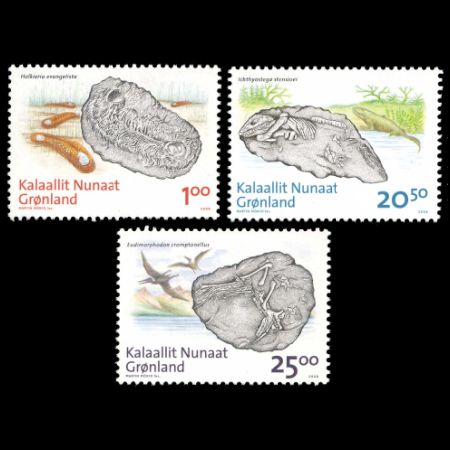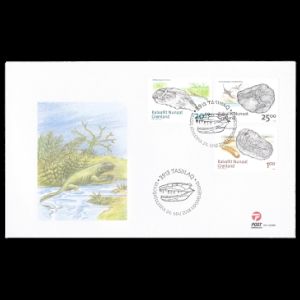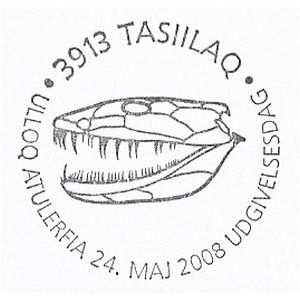Greenland 2008 "Fossils in Greenland (I)"
| <prev | back to index | next> |
| Issue Date | 24.5.2008 |
| ID | Michel: 512-514, Scott: 521-523, Stanley Gibbons: 552-554, Yvert et Tellier: 492-494, Category: pF |
| Design | Martin Mörck - illustrations and the engravings |
| Stamps in set | 3 |
| Value |
DKK 1.00 - Halkieria evangelista DKK 20.50 - Ichthyostega stensioei DKK 25.00 - Eudimorphodon cromptonellus |
| Emission/Type | commemorative, |
| Issue places | Tasiilaq |
| Size (width x height) | 39.52 x 28.84 mm |
| Layout | 3 sheets of 40 stamps each |
| Products | FDC x1, MC x3 |
| Paper | TR4 |
| Perforation | 13,25 x 13,25 |
| Print Technique | Offset lithography and Recess |
| Printed by | POST Danmark |
| Quantity |
Halkieria evangelista: 253.563, Ichthyostega stensioei: 90.269, Eudimorphodon: 123.532 |
| Issuing Authority | POST Greenland |

On April 24th, 2008, the Post Authority of Greenland issued the first of two stamp sets "Fossils of Greenland". The second sets was issued in the following year.
The illustrations and the engravings are made by the Norwegian Martin Mörck.
Mörck (born 8 June 1955) primarily engraved for the postal services of the Nordic countries, but also for the postal services of France, Monaco, Canada, Greenland and Latvia. In 2017, Mörck engraved the Souvenir-Sheet from "Chinese Dinosaurs" stamps set.
The following text was written by David Harper, professor in Paleontology at Copenhagen University and Mona Elmgaard Conservator. The text was published in "Greenland Collector" magazine in April 2008.
David Harper is Professor in Palaeontology at Copenhagen University. That makes him Curator for the Palaeontological collection, including the Type Collection at the Geodetical Museum in Copenhagen, part of the State Natural History Museum. His investigation fields are aimed at fossils and ecological systems in the lower Palaeozoic in Greenland, Great Britain and China. David Harper is also Chairman of a number of commissions and union.
The geology of Greenland has a remarkable large number of rock structures that stretches over almost four billion years of history of the Earth. In fact, sedimentary deposits from Isua in West Greenland reveal the earliest proof of known life, in the shape of micro-organisms, existing 3,8 billion years ago. Life developed later in species and numbers and left its marks on geological history. Rocks and fossils in Greenland have given us an insight into the development of animals and plants throughout the history of the Earth. The first series of stamps on this subject illustrates important events in life on Earth by showing unique fossils from Greenland. In the geological Age, Cambrian, a riot of different species arose, which later lead to the inhabitation of the earth and the sky by toads and pterodactyls respectively.
Halkrieria evangelista is an astonishing animal. It looks like a worm with two shells, one at each end of its body. It was first found in Cambric rocks on Bornholm; only a few shells were found which, for the most part made it look like a sea shell. The fossil from the Pass of Sirius in North Greenland was collected by The Geological Institute of Greenland in 1980. The find was complete with two shells and it showed that it belonged to the mollusca but it did not look at all like something we know of today. The fauna of Sirius contains many strange and undiscovered animals and that testifies to a world-wide development of new kinds of life, e.g. during the Cambrian Explosion 250 billion years ago, when a high amount of new complex organisms developed very fast.
Ichthyostega stensioei is one of the first amphibians. In the geological age, Devonian, the land was already green and contained different species of spiders, insects and molluscs. At the end of Devonian about 360 million ago, the vertebrates followed. The first specimen of Ichthyostega was collected by Swedish expeditions in East Greenland in the 1920s and 1930s. At first it was taken for a terrestrial toad, but later it came to show that it lived in water; however, sometimes it would pull itself ashore, where it most likely fed on insects.
Eudimorphodon cromptonellus is a small pterodactyl that was one of the first vertebrates to develop the ability of flying.
The specimen was found by the Carlsberg Fjord in East Greenland in the 1990s by an expedition from Harvard University. Eudimorphodon existed in Greenland at the same time as the first dinosaurs (such as Plateosaurus), toads, fish and mammals. The sky was crowded with flying insects and hovering lizards but proper pterodactyls were the first to develop flying at own force in Sen Trias, 220 billion years ago. The mentioned fossils can be found at the Geological Museum in Copenhagen.
Products and associated philatelic items
| FDC | First-Day-of-Issue Postmarks | |
 |
 |
|
| Reconstruction of Ichthyostega stensioei depicted on the cachet of the FDC. | Skull of Ichthyostega stensioei shown on th postmark |
References

|
-
Technical details and brief stamps description:
Greenland Collector", vol. 13, No 2, April 2008
Acknowledgements:
Many thanks to Dr. Peter Voice from Department of Geological and Environmental Sciences, Western Michigan University, for the draft page review.
| <prev | back to index | next> |